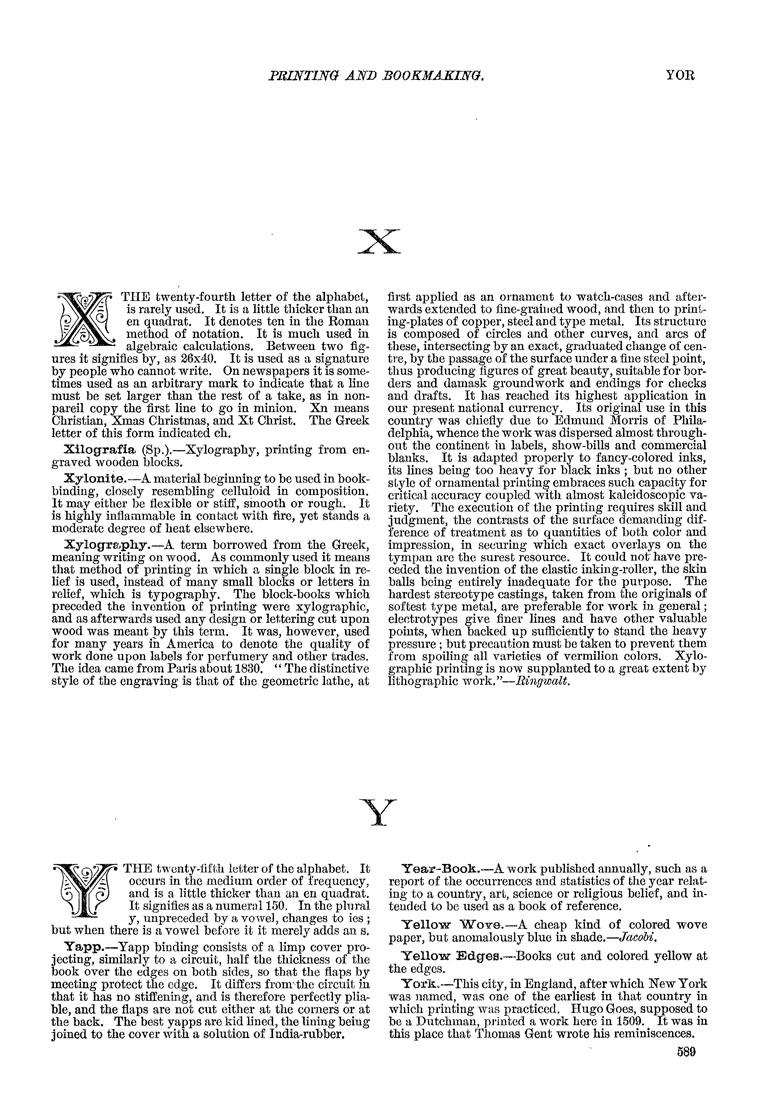PRINTING AND BOOKMAKING,
YOR
^X^
THE twenty-fourth letter of the alphabet,
is rarely used. It is a little thicker than an
en quadrat. It denotes ten in the Roman
method of notation. It is much used in
algebraic calculations. Between two fig¬
ures it signifies by, as 26x40. It is used as a signature
by people who cannot write. On newspapers it is some¬
times used as an arbitrary mark to indicate that a line
must be set larger than the rest of a take, as in non¬
pareil copy the first line to go in minion. Xn means
Christian, Xmas Christmas, and Xt Christ. The Greek
letter of this form indicated ch.
Xilografia (Sp.).—Xylography, printing from en¬
graved wooden blocks.
Xylonite.—A material beginning to be used in book¬
binding, closely resembling celluloid in composition.
It may either be flexible or stiff, smooth or rough. It
is highly inflammable in contact with fire, yet stands a
moderate degree of heat elsewhere.
Xylogr8,phy.—A term borrowed from the Greek,
meaning writing on wood. As commonly used it means
that method of printing in which a single block in re¬
lief is used, instead of many small blocks or letters in
relief, which is typography. The block-books which
preceded the invention of printing were xylographic,
and as afterwards used any design or lettering cut upon
wood was meant by this term. It was, however, used
for many years in America to denote the quality of
work done upon labels for perfumery and other trades.
The idea came from Paris about 1830. '' The distinctive
style of the engraving is that of the geometric lathe, at
first applied as an ornament to watch-cases and after¬
wards extended to fine-grained wood, and then to print¬
ing-plates of copper, steel and type metal. Its structure
is composed of circles and other curves, and arcs of
these, intersecting by an exact, graduated change of cen¬
tre, by the passage of the surface under a fine steel point,
thus producing figures of great beauty, suitable for bor¬
ders and damask groundwork and endings for checks
and drafts. It has reached its highest application in
our present national currency. Its original use in this
country was chiefly due to Edmund Morris of Phila¬
delphia, whence the work was dispersed almost through¬
out the continent in labels, show-bills and commercial
blanks. It is adapted property to fancy-colored inks,
its lines being too heavy for black inks ; but no other
style of ornamental printing embraces such capacity for
critical accuracy coupled with almost kaleidoscopic va¬
riety. The execution of the printing requires skill and
judgment, the contrasts of the surface demanding dif¬
ference of treatment as to quantities of both color and
impression, in securing which exact overlays on the
tympan are the surest resource. It could not have pre¬
ceded the invention of the elastic inking-roller, the skin
balls being entirely inadequate for the purpose. The
hardest stereotype castings, taken from the originals of
softest type metal, are preferable for work in general;
electrotypes give finer lines and have other valuable
points, when backed up sufficiently to Stand the heavy
pressure; but precaution must be taken to prevent them
from spoiling all varieties of vermilion colors. Xylo¬
graphic printing is now supplanted to a great extent by
lithographic work."—Ringwalt.
Y
THE twenty-fifth letter of the alphabet. It
occurs in the medium order of frequency,
and is a little thicker than an en quadrat.
It signifies as a numeral 150, In the plural
y, unpreceded by a vowel, changes to ies ;
but when there is a vowel before it it merely adds an s.
Yapp.—Yapp binding consists of a limp cover pro¬
jecting, similarly to a circuit, half the thickness of the
book over the edges on both sides, so that the flaps hy
meeting protect the edge. It dift'ers from the circuit in
that it has no stiffening, and is therefore perfectly plia¬
ble, and the flaps are not cut either at the corners or at
the back. The best yapps are kid lined, the lining being
joined to the cover with a solution of India-rubber.
Tear-Book.-—A work published annually, such as a
report of the occurrences and statistics of the year relat¬
ing to a country, art, science or religious belief, and in¬
tended to be used as a book of reference.
Yellow "WoYO.—A cheap kind of colored wove
paper, but anomalously blue in shade.—Jacohi,
Yellow Edges-—-Books cut and colored yellow at
the edges.
York.—This city, in England, after which New York
was named, was one of the earliest in that country in
which printing was j)racticed. Hugo Goes, supposed to
be a Dutchman, printed a work here in 1509. It was in
this place that Thomas Gent wrote his reminiscences.
589
|








